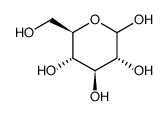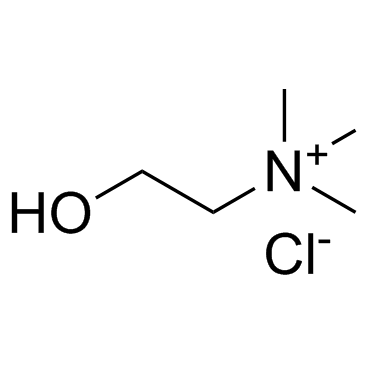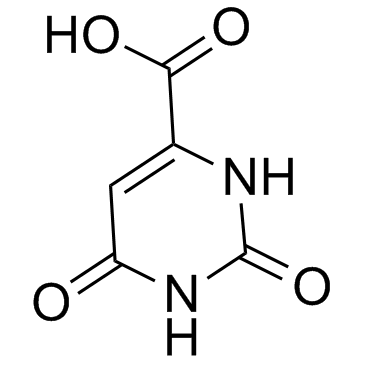987-78-0
| Name | CDP-choline |
|---|---|
| Synonyms |
cytidinediphosphocholine
recofnan CDP-choline Citicoline colite nicolin MFCD00868097 nicholin cereb 5'-O-[Hydroxy({[2-(trimethylammonio)ethoxy]phosphinato}oxy)phosphoryl]cytidine Reagin Audes Cytidine, 5'-O-[hydroxy[[hydroxy[2-(trimethylammonio)ethoxy]phosphinyl]oxy]phosphinyl]-, inner salt cytidine diphosphate choline EINECS 213-580-7 Rexort CYTIDINE 5'-DIPHOSPHOCHOLINE ensign cytidine-5'-diphosphocholine Citifar |
| Description | Citicoline is an intermediate in the synthesis of phosphatidylcholine, a component of cell membranes. Citicoline exerts neuroprotective effects. |
|---|---|
| Related Catalog | |
| In Vitro | To determine the potential neuroprotective activity of Citicoline and Homotaurine, treated retinal cells are treated with increasing concentrations of Citicoline or Homotaurine for 24 hours. 1 μM, 10 μM and 100 μM of Citicoline or Homotaurine are used to investigate whether may contribute to a reduced cell viability in retinal cells. Retinal cells are well preserved in Citicoline- or Homotaurine-treated cultures, with no evidence of toxicity or significant loss of viability after treatments. 100 μM of Citicoline is not harmful to retinal neuroglial cells in vitro and 100 μM of Homotaurine is an effective concentration to enhance neuroprotection in a model of experimental glaucoma. Therefore, this concentration of Citicoline and Homotaurine is used for all subsequent experiments. To evaluate whether cotreatment with Citicoline and Homotaurine is able to induce a synergistic neuroprotective effect against glutamate excitotoxicity, retinal cell cultures are exposed to Citicoline 100 μM, Homotaurine 100 μM, and Citicoline+Homotaurine 100 μM, 24 hours before glutamate treatment. In the presence of 100 μM Citicoline, a significant increase in cell viability is observed[1]. |
| In Vivo | Administration of Citicoline in a dose of 1000 mg/kg produces more pronounced increase in the threshold of clonic seizures and tonic phase of seizures with lethal outcome (by 18.54 and 50.08% respectively, in comparison with the control). The anticonvulsant effect is most pronounced after injection of Citicoline in a dose of 1000 mg/kg[2]. |
| Cell Assay | The assay used to assess cell viability in retinal cells was the MTT reduction assay. To evaluate the effect of Citicoline and Homotaurine on cell survival, the cells are subdivided into three groups and treated for 24 hours with 1 μM, 10 μM, and 100 μM of Citicoline and with 1 μM, 10 μM and 100 μM of Homotaurine. To evaluate the neuroprotective effects of Citicoline and Homotaurine, cells are treated with Citicoline 100 μM, Homotaurine 100 μM, or Citicoline+Homotaurine 100 μM, 24 hours before glutamate treatment and 30 min before high glucose (HG) treatment. MTT is added to wells at a final concentration of 0.5 mg/mL for 1 hour at 37°C. After this time, the medium is removed and reduced MTT (blue formazan product) is solubilized by adding 100 μL DMSO to each well. After agitation of plates for 15 min, the optical density of the solubilized formazan product in each well is measured using an automatic microplate reader with a 570 nm test wavelength and a 690 nm reference wavelength[1]. |
| Animal Admin | Mice[1] Experiments are performed on male C57Bl/6 mice (n=69) weighing 23-27 g. The study is performed in two series. In series I, the dose-dependent effect of Citicoline on the seizure threshold in mice is evaluated. The measurements are performed 1 h after Citicoline administration. Citicoline in doses of 500 and 1000 mg/kg (0.04 mL per 20 g body weight) is injected intraperitoneally. The control animals receive an equivalent volume of physiological saline under similar conditions. In series II, the duration of Citicoline effect is estimated in 3 and 6 h after single intraperitoneal injection of Citicoline. |
| References |
| Boiling Point | 851.4ºC at 760 mmHg |
|---|---|
| Molecular Formula | C14H26N4O11P2 |
| Molecular Weight | 488.324 |
| Exact Mass | 488.107330 |
| PSA | 235.34000 |
| LogP | -7.07 |
| Storage condition | -20℃ |
CHEMICAL IDENTIFICATION
HEALTH HAZARD DATAACUTE TOXICITY DATA
|
| Hazard Codes | Xi |
|---|---|
| HS Code | 2942000000 |
| HS Code | 2942000000 |
|---|





